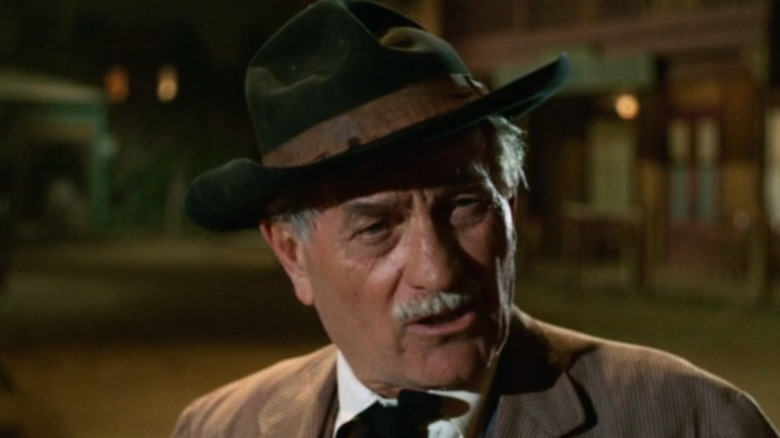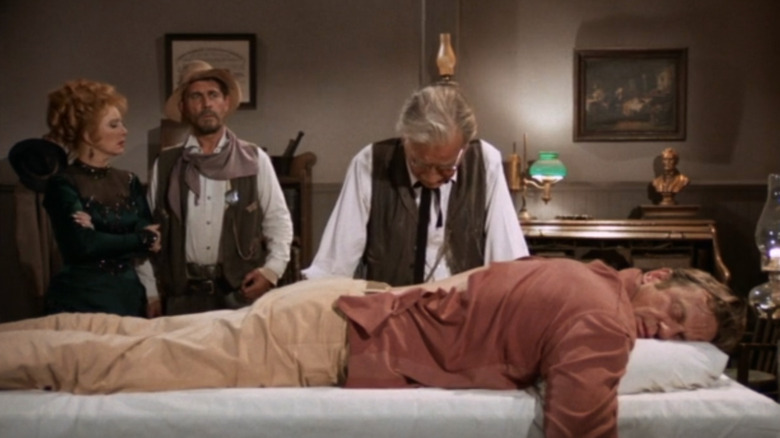Why Milburn Stone Wanted To Keep Violence In Gunsmoke
Every principal cast member on the CBS western drama "Gunsmoke" had their part to play, and for the most part, they maintained their small screen occupations over the course of their tenures. If trouble ever came to the Long Branch Saloon, Amanda Blake's (unmarried) Miss Kitty was always thrust in the middle of it. Should an outsider present a threat to the folks of Dodge City, James Arness' Marshal Matt Dillon was often the purveyor of justice. But Milburn Stone's Galen Adams, otherwise referred to as Doc, was always front and center whenever someone fell ill or needed a bullet pulled out of them.
Where most of the "Gunsmoke" characters are proficient at taking lives, Doc is saddled with the greater responsibility of saving them. Stone was the only other actor in the "Gunsmoke" lineup, besides Arness, who was present throughout its staggering 20-season run. He brought a grandfatherly approach to the role, often alternating between a sly grouch and a kind-hearted soul that makes him one of Dodge City's most trusted fixtures. It's easy to be a bit of a grouch when you're pulling lead out of bodies over the course of 600 episodes.
Throughout the '60s, there were fluctuations when it came to violence on network television, with "Gunsmoke" often being caught in the crossfire. But self-censoring was a sentiment Stone believed was the wrong move, especially in the context of a series that takes place in the days of the wild west (via MeTV):
"The trend is now to eliminate all violence as much as possible, and I think that's a ridiculous attitude; I don't like senseless force anymore than the next guy, but violence was in the Old West."
Stone believed violence was integral to the show's lessons about the Wild West
Stone further expanded upon his frustrations with CBS' distancing from television violence, claiming that "Gunsmoke" served as a moralistic depiction that paints a picture of a different time and its consequences:
"Violence in period pieces isn't the same as in the contemporary shows; In the end, we always show that crime doesn't pay. There's a psychological difference between characters in costumes and characters who dress like the guy next door."
The violence of "Gunsmoke" was relatively tame from a contemporary perspective, but to Stone's point, neutering violence robs it of its forceful presence. Whenever an episode featured someone getting shot, they would either fall over and/or be shown with a red spot on their person. The most violent aspect would often be the bellowing roar that emitted from the pistols themselves. But those touches still present the weight of a gun going off as a last resort weapon of death (something HBO's "Barry" also did decades later).
What's most interesting is that "Gunsmoke" was still a ratings hit throughout the '60s, especially as big screen westerns, which often employed the same tricks, expanded upon their portrayal of violence. The clean-cut genre heroes of the wild west like Marshal Dillon were starting to get overwhelmed by the complicated anti-hero types of Sergio Leone and Sam Peckinpah. For as much flack as those filmmakers received for their depiction of violence at the time, something like "The Wild Bunch" is still effective because it presented an honest picture of how frightening a random shootout in a bustling town is.
"Gunsmoke" could only go so far being on network television, but Stone's words serve as a time-honored reminder that depiction doesn't exactly equate to endorsement.
Every episode of "Gunsmoke" is currently streaming on Pluto TV.

